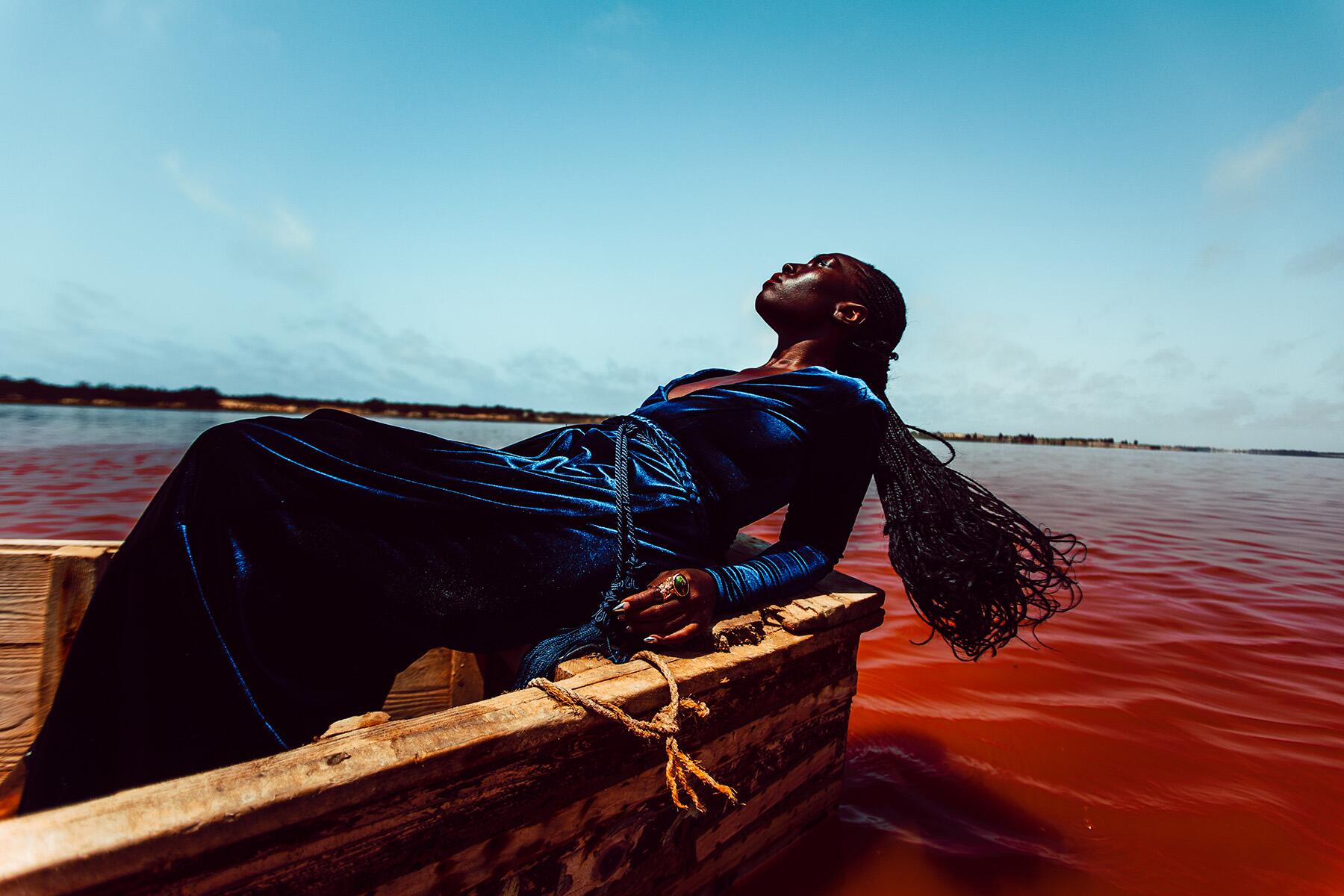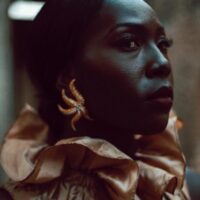Ever since I watched director Djibril Diop Mambety’s cinematic poem of a film, Touki Bouki, I have been captivated by the idea of his home country, Senegal. If the uneven pacing, vibrant color juxtapositions, and very spirit of this film, described by director Martin Scorsese as, “mad with raw, wild energy,” was anything to go by, then Senegal, the country where it is set, promised to be a magnificent immersion. And despite being filmed in the 1970s, if the work of an artist can say anything about where he is from–if the essence of a place is an abiding entity despite the imprints of time–then I was certain the Dakar and Senegal of today would be as magical, gritty, real, colorful, and rhapsodic as the one that unfolds with unattenuated vigor in Mambety’s masterpiece.
Touki Bouki is something of a road film, fueled by a colorful cast of memorable characters whose impact on the drama is not necessarily in direct correlation to their time spent on screen. Well, if Ghanaian writer Ama Ata Aidoo was right when she opined that, “Humans, not places, make memories,” then it is understandable that what endures above all in my consciousness are the people I met along the way as we traveled through the country.
Recommended Fodor’s Video
Making my way from Ghana, I flew Air Cote d’Ivoire from Accra to Dakar with a layover in Abidjan. I left Dakar early the next morning, embarking on a four-hour drive to the northwestern coastal town of Saint-Louis. Walking into the palm-fringed open courtyard of the home of my host, Marie-Caroline Camara, a deliciously decaying maison d’hôtes which she has named Au Fils du Fleuve, I was immediately transported as I watched the shadows of palm fronds dance on whatever expanse of tawny-colored wall not festooned with local art. In this would-be film from a distant time, protagonist Marie-Caroline did not disappoint with the drama, regaling us with stories of growing up métise (mixed-race) with one French grandmother and one Fulani (an ethnic group from the West-African Sahel) in the former French colony. This breakfast repartee was served with a side of baobab juice and bissap (hibiscus tea) and homemade lime preserves, showcasing the bounty of the region.

Soon after breakfast, she sent us on our way with her neighbor, a bricolage artist named Bassirou Fall, to discover the port city in an old jalopy of a horse-drawn carriage called a caleche. The rhythmic click-clack of hooves played a perfect score to the montage of the town and its life–herds of sheep ambling aimlessly, children kicking around a soccer ball, stores ranging from a cavernous bookshop to an emporium of textile collected from all over the continent. Bassiorou, or “Bas” as we soon came to know him, was to play a central role in our sojourn in Senegal. He explained to us that culturally, sheep were like a bank in which people kept their money. He prepared us for the curated chaos we would encounter the next morning when we went at dawn to watch the fisherman return with their catch in colorful pirogues (fishing canoes). Saint-Louis breathed the mysterious air that port cities tend to do with their ineffable sense of transition, of far-flung lands coming to one shore, of ships leaving, but also of ships always coming back.
We left Saint-Louis that afternoon for the village of Guéréo, situated on Senegal’s Petite-Côte coastline south of Dakar. Guéréo is a village of wild sea and brick-red earth; a place to do little else but melt into nature. The eco-lodge where we stayed, Les Manguiers de Guéréo, made for a comfortable base from which to do just that. The plunge pool on the terrace of my room faced the mangrove–a fitting spot from which to watch the sunrise over the wetlands. We spent our first morning with Tamsir, a local fisherman and guide, gliding through the mangroves on his cobalt blue pirogue in absolute serenity. The most authentic way to get around Saint-Louis though is en charente (a horse-drawn cart) and so we spent our afternoon promenading in one through the sparse baobab forest. “Souris,” which means mouse in French, was our driver, who carted us across the earth and under a fairytale blue sky.

The following morning, we were picked up by Fallou Mboup, a travel guide for over 30 years. I felt as though I had known Fallou for a lifetime. Prior to our arrival, to our arrival in the land of Teranga, he and I had corresponded via WhatsApp, refining the plot, structure, and flow of the trip. Finally putting a face to the voice notes that had calmly quelled my exasperation during trip-planning, we would spend the remainder of our days being shepherded around Dakar by Fallou, a dandy of a man who was always dressed to the nines, whether it was in a caramel-colored traditional grand boubou or a pastiche jogger set with matching baseball cap.
Dakar felt dizzying and languid in one fell swoop. The ambiance was alive, the energy of the people warm and open. Our initial welcome to the city came from Sabrina, a charming hostess and owner of the hotel where we stayed. Her Boma Lifestyle Hotel is one known as much for its comfortable rooms and tasty cuisine as it is for its pulsating nightlife. On our first day, Fallou took us to the bustling Sandagar Market to meet his tailor, Mor, who would be tasked with making us some traditional pieces. The market was thick with people and we bobbed and wove through the throng until we reached the tailor’s row, animated by hands swiftly cutting fabric and the steady whirr of sewing machines. The following day it was time for craft shopping at the Soumbedioune Market. By now, we had found out that Bas from Saint-Louis was in Dakar and so he joined us on our escapades, helping us pick through sweetgrass baskets. Bas took us to the medina to visit the shop of furniture designer Ousmane Mbaye. Mbaye, who also has a showroom in Le Marais in Paris, happened to be there at the time of our visit. He is a tall man with an enormous smile and a kind presence. We talked with him, standing among his variegated metal furniture, about the creatives of Dakar and Senegal at large.
No visit to Dakar is complete with a trip to Gorée Island, the tiny, sprightly, former European settlement which is home to the Maison des Esclaves (The House of Slaves). Here, we confronted the dark history of the transatlantic slave trade and the role this bright little isle played in its propagation. It was hard and heavy to imagine the magnitude of pain incubated on and unleashed from such an infinitesimal expanse of the earth. Thankfully, as we exited the house, a man named Omar infused light into the gravitas of the moment as he stood singing covers of Akon acapella, shaking a kashaka (a percussion instrument consisting of two small gourds filled with beans).

Naturally, some of my most potent connections in Senegal were made around food. Perhaps the most memorable of those was when Fallou took as to his home so I could learn to make Theibou Djenne (a one-pot delectation of rice). Fallou’s three wives and his nieces led the charge, instructing me in the kitchen on the preparation of the dish. Bintou, Yaye Maimouna, Mame Khady, and Boye Mbaye were stern but loving with me, directing me on how and when to stir the pot, how to prepare the platter, and where to sit to eat (as I found out, while the eating is communal, men and women sit and share separately).
On our last night in Senegal, I was finally able to meet the woman who sewed the seed (after Mambety that is) for my visit to Senegal: Fatou Jobe, founder of basket weaving collective Imadi World. Being of mixed Senegambian ancestry, Fatou served us Gambian dishes like Nyambeh Nyebbeh Ak Abala (cassava with black-eyed peas and sauce) in her literature and art-filled home. Breaking bread with Fatou, who had been instrumental in transmuting this trip from idea to reality, rounded off our two weeks of encountering and sharing space and time with the most varied of individuals, and felt like just the right closing scene to our visit.

By the time I was to leave, I was full of gratitude for having lived this rich experience and connecting with so many unforgettable beings during my time in Dakar.
Returning to New York City via Turkish Airlines afforded me the luxury of an extended layover in another land I have been meaning to explore—Turkey— the plunge into which began on board my flight where the airline’s “flying chefs” served the best of Turkish Cuisine in business class and, of course, continued in the airline’s lounge which even had a station dedicated to pide (pizza-like Turkish flatbread).
In Istanbul, I checked into the opulent suites of the Ciragan Palace Kempinski with all of its layered history, Ottoman and otherwise, overlooking the Bosphorus. My truest Turkish delight, however, was Cappadocia, the Anatolian region renowned for its distinctive “fairy chimneys” (vertiginous, cone-shaped rock formations). While Cappadocia is something of an “Instagrammer’s Paradise” teeming with camera-toting influencers poised to ensnare the perfect shot of hot air balloons floating in the dawn sky, the land itself is as real as it gets, even if it does resemble something out a fairytale. There is something entrancing about the age of the stone and the manner in which the peaks and valleys seem to spread out ad infinitum. And the additional touch of fairy dust? Museum Hotel, the Relais & Chateaux property I called home, is perhaps one of the most enchanting places I have ever laid my head. In its heated rooftop pool, I took morning swims watching the hot air balloons rise in the distance, and I took night swims, drinking in the starlight. I did leave the hotel, loathe though I was to, to go horseback riding through the peaks with Dalton Brothers Ranch and for an early morning hot air balloon ride with Turkaz Balloons. And I owed every second of my Cappadocian caper to Feeling Cappadocia’s Merve, the “producer” of a concierge who organized the final act of this “travel film” to perfection.
Yes, places matter. But without a doubt, it’s the people who make the places.




